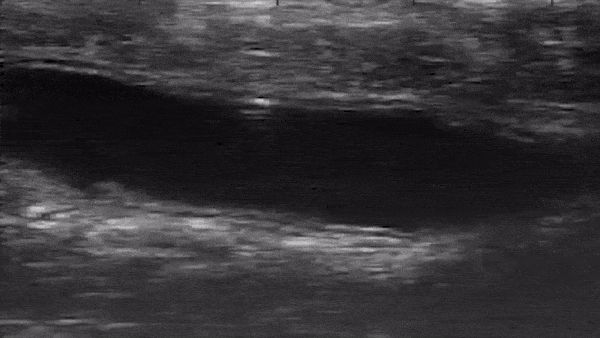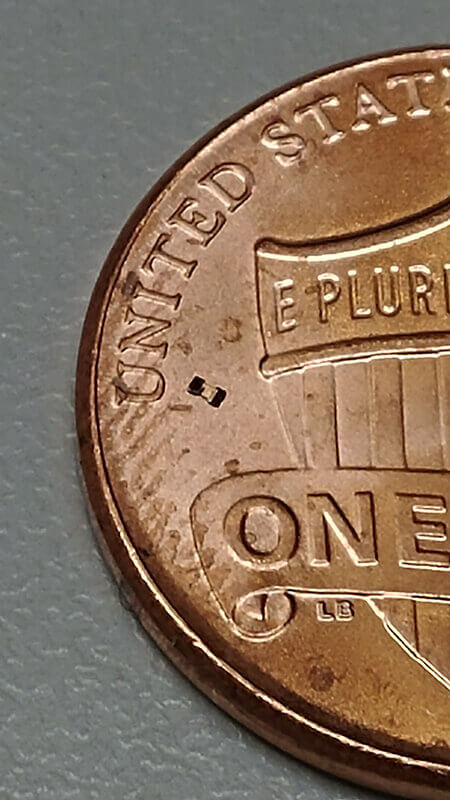October 15, 2020
All-terrain microrobot flips through a live colon

Live ultrasound footage shows a microrobot tumbling through a colon in vivo. (Purdue University video/Elizabeth Niedert and Chenghao Bi)
WEST LAFAYETTE, Ind. — A rectangular robot as tiny as a few human hairs can travel throughout a colon by doing back flips, Purdue University engineers have demonstrated in live animal models.
Why the back flips? Because the goal is to use these robots to transport drugs in humans, whose colons and other organs have rough terrain. Side flips work, too.
Why a back-flipping robot to transport drugs? Getting a drug directly to its target site could remove side effects, such as hair loss or stomach bleeding, that the drug may otherwise cause by interacting with other organs along the way.
The study, published in the journal Micromachines, is the first demonstration of a microrobot tumbling through a biological system in vivo. Since it is too small to carry a battery, the microrobot is powered and wirelessly controlled from the outside by a magnetic field.
“When we apply a rotating external magnetic field to these robots, they rotate just like a car tire would to go over rough terrain,” said David Cappelleri, a Purdue associate professor of mechanical engineering. “The magnetic field also safely penetrates different types of mediums, which is important for using these robots in the human body.”
The researchers chose the colon for in vivo experiments because it has an easy point of entry – and it’s very messy.
“Moving a robot around the colon is like using the people-walker at an airport to get to a terminal faster. Not only is the floor moving, but also the people around you,” said Luis Solorio, an assistant professor in Purdue’s Weldon School of Biomedical Engineering.
“In the colon, you have all these fluids and materials that are following along the path, but the robot is moving in the opposite direction. It’s just not an easy voyage.”
But this magnetic microrobot can successfully tumble throughout the colon despite these rough conditions, the researchers’ experiments showed. A video explaining the work is available on YouTube.
The team conducted the in vivo experiments in the colons of live mice under anesthesia, inserting the microrobot in a saline solution through the rectum. They used ultrasound equipment to observe in real time how well the microrobot moved around.
The microrobots could also tumble in colons excised from pigs, the researchers found, which have similar guts to humans.
 The microrobot can be seen just to the right of the “U” in United States on this U.S. penny. (Purdue University image/Georges Adam)
The microrobot can be seen just to the right of the “U” in United States on this U.S. penny. (Purdue University image/Georges Adam)
“Moving up to large animals or humans may require dozens of robots, but that also means you can target multiple sites with multiple drug payloads,” said Craig Goergen, Purdue’s Leslie A. Geddes Associate Professor of Biomedical Engineering, whose research group led work on imaging the microrobot through various kinds of tissue.
Solorio’s lab tested the microrobot’s ability to carry and release a drug payload in a vial of saline. The researchers coated the microrobot with a fluorescent mock drug, which the microrobot successfully carried throughout the solution in a tumbling motion before the payload slowly diffused from its body an hour later.
“We were able to get a nice, controlled release of the drug payload. This means that we could potentially steer the microrobot to a location in the body, leave it there, and then allow the drug to slowly come out. And because the microrobot has a polymer coating, the drug wouldn’t fall off before reaching a target location,” Solorio said.
The magnetic microrobots, cheaply made of polymer and metal, are nontoxic and biocompatible, the study showed. Cappelleri’s research group designed and built each of these robots using facilities at the Birck Nanotechnology Center in Purdue’s Discovery Park.
Commonly-used roll-to-roll manufacturing machinery could potentially produce hundreds of these microrobots at once, Cappelleri said.
The researchers believe that the microrobots could act as diagnostic tools in addition to drug delivery vehicles.
“From a diagnostic perspective, these microrobots might prevent the need for minimally invasive colonoscopies by helping to collect tissue. Or they could deliver payloads without having to do the prep work that’s needed for traditional colonoscopies,” Goergen said.
This research is part of the Purdue Center for Cancer Research and aligns with Purdue Engineering Initiatives in Autonomous and Connected Systems and Engineering-Medicine. The work is supported by the National Science Foundation and the National Cancer Institute at the National Institutes of Health.
About Discovery Park
Discovery Park is a place where Purdue researchers move beyond traditional boundaries, collaborating across disciplines and with policymakers and business leaders to create solutions for a better world. Grand challenges of global health, global conflict and security, and those that lie at the nexus of sustainable energy, world food supply, water and the environment are the focus of researchers in Discovery Park. The translation of discovery to impact is integrated into the fabric of Discovery Park through entrepreneurship programs and partnerships.
About Purdue University
Purdue University is a top public research institution developing practical solutions to today’s toughest challenges. Ranked the No. 5 Most Innovative University in the United States by U.S. News & World Report, Purdue delivers world-changing research and out-of-this-world discovery. Committed to hands-on and online, real-world learning, Purdue offers a transformative education to all. Committed to affordability and accessibility, Purdue has frozen tuition and most fees at 2012-13 levels, enabling more students than ever to graduate debt-free. See how Purdue never stops in the persistent pursuit of the next giant leap at https://purdue.edu/.
Writer, Media contact: Kayla Wiles, 765-494-2432
Sources: David Cappelleri, dcappell@purdue.edu
Craig Goergen, cgoergen@purdue.edu
Luis Solorio, lsolorio@purdue.edu
Journalists visiting campus: Journalists should follow Protect Purdue protocols and the following guidelines:
- Campus is open, but the number of people in spaces may be limited. We will be as accommodating as possible, but you may be asked to step out or report from another location.
- To enable access, particularly to campus buildings, we recommend you contact the Purdue News Service media contact listed on the release to let them know the nature of the visit and where you will be visiting. A News Service representative can facilitate safe access and may escort you on campus.
- Correctly wear face masks inside any campus building, and correctly wear face masks outdoors when social distancing of at least six feet is not possible.
ABSTRACT
A Tumbling Magnetic Microrobot System for Biomedical Applications
Elizabeth E. Niedert, Chenghao Bi, Georges Adam, Elly Lambert, Luis Solorio, Craig J. Goergen and David J. Cappelleri
DOI: 10.3390/mi11090861
A microrobot system comprising an untethered tumbling magnetic microrobot, a two-degree-of-freedom rotating permanent magnet, and an ultrasound imaging system has been developed for in vitro and in vivo biomedical applications. The microrobot tumbles end-over-end in a net forward motion due to applied magnetic torque from the rotating magnet. By turning the rotational axis of the magnet, two-dimensional directional control is possible and the microrobot was steered along various trajectories, including a circular path and P-shaped path. The microrobot is capable of moving over the unstructured terrain within a murine colon in in vitro, in situ, and in vivo conditions, as well as a porcine colon in ex vivo conditions. High-frequency ultrasound imaging allows for real-time determination of the microrobot’s position while it is optically occluded by animal tissue. When coated with a fluorescein payload, the microrobot was shown to release the majority of the payload over a 1-h time period in phosphate-buffered saline. Cytotoxicity tests demonstrated that the microrobot’s constituent materials, SU-8 and polydimethylsiloxane (PDMS), did not show a statistically significant difference in toxicity to murine fibroblasts from the negative control, even when the materials were doped with magnetic neodymium microparticles. The microrobot system’s capabilities make it promising for targeted drug delivery and other in vivo biomedical applications.
Note to journalists: A video explaining the microrobot research is available on YouTube. Additional video and photos of the tumbling microrobots are available via Google Drive. The paper is available online open-access at the journal’s website. Journalists visiting campus should follow visitor health guidelines.

